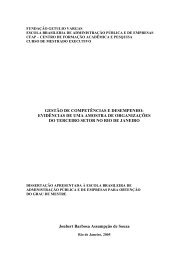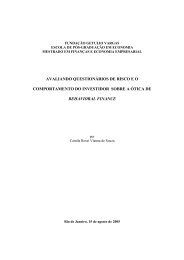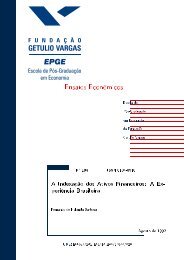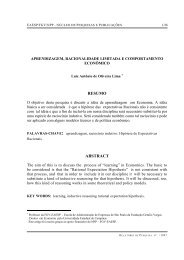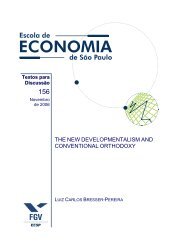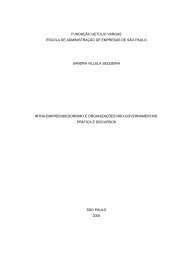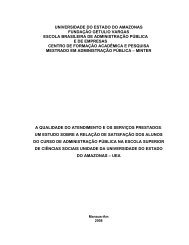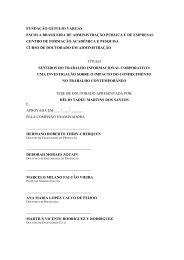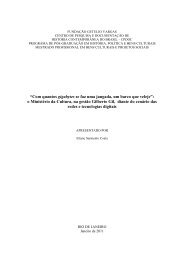Ensaios Econômicos - Sistema de Bibliotecas da FGV - Fundação ...
Ensaios Econômicos - Sistema de Bibliotecas da FGV - Fundação ...
Ensaios Econômicos - Sistema de Bibliotecas da FGV - Fundação ...
Create successful ePaper yourself
Turn your PDF publications into a flip-book with our unique Google optimized e-Paper software.
one dimension vanishes, e.g., as 11 ! 0, we are able to compute its limit as:<br />
lim M (t 1; t 2 ) M 2 (t 1 ; t 2 ) = exp<br />
t 1 1 + t 2 2 + 1 <br />
11 !0 2 t2 2 22 :<br />
From Levi’s Continuity Theorem, the …rst two moments of the limiting distribution can be<br />
<strong>de</strong>termined respectively by:<br />
"<br />
# " #<br />
d<br />
dt M t=0<br />
1<br />
1<br />
2 (0; 0) = M 2 (t 1 ; t 2 )<br />
=<br />
( 2 + t 2 22 )<br />
2<br />
"<br />
# "<br />
#<br />
d 2<br />
dt 2 M 2 1 1 ( 2 + t 2 22 ) t=0<br />
2 1 1 2<br />
2 (0; 0) = M 2 (t 1 ; t 2 )<br />
1 ( 2 + t 2 22 ) 22 + ( 2 + t 2 22 ) 2 =<br />
1 2 22 + 2 ;<br />
2<br />
" !<br />
!#<br />
1 0 0<br />
implying that the distribution converges in law to the <strong>de</strong>generate Normal N ;<br />
.<br />
2 0 22<br />
By the Disintegration Theorem, a <strong>de</strong>nsity can be <strong>de</strong>…ned for such distribution on a restriction<br />
of (" the original # " 2-dimensional " Lebesgue measure " to the a¢ ne subspace<br />
x 1<br />
=<br />
x 2<br />
#<br />
1<br />
+<br />
2<br />
f (x 1 ; x 2 ) =<br />
=<br />
=<br />
# "<br />
0 0<br />
0 22<br />
#<br />
v 1<br />
:<br />
v 2<br />
(<br />
1<br />
p exp 222<br />
(<br />
1<br />
p exp 222<br />
(<br />
1<br />
p exp 222<br />
#<br />
v 1<br />
2 R<br />
). 2 It is given by:<br />
v 2<br />
"<br />
1<br />
2 [x 1 1 ; x 2 2 ]<br />
1<br />
2 [x 1 1 ; x 2 2 ]<br />
)<br />
1 [x 2 2 ] 2<br />
;<br />
2 22<br />
"<br />
# + "<br />
0 0<br />
0 22<br />
0 0<br />
0 1<br />
22<br />
# "<br />
#)<br />
x 1 1<br />
x 2 2<br />
#)<br />
x 1 1<br />
x 2 2<br />
" # + " #<br />
0 0<br />
0 0<br />
where<br />
is the Moore-Penrose (pseudo or generalized) inverse matrix of<br />
,<br />
0 22 0 22<br />
which pseudo-inverse <strong>de</strong>terminant 5 is given by 22 . As the last line makes clear, this is the <strong>de</strong>nsity<br />
of univariate random variable N [ 2 ; 22 ]. A symmetric result applies when 22 ! 0.<br />
Therefore, <strong>de</strong>generating the bivariate Normal distribution in one dimension does not a¤ect either<br />
the mean or the variance of the other dimension, allowing to <strong>de</strong>termine exactly what the remaining<br />
univariate distribution will be. As expected, the covariance will vanish as well, since the covariance<br />
of a constant with a random variable should be zero.<br />
The result in Proposition 1 allows performing counter-factual exercises when we shut out either<br />
permanent or transitory shocks. As it becomes clear in the next section, we evaluate the welfare<br />
5 See Magnus and Neu<strong>de</strong>cker (1988) for the <strong>de</strong>…nition and properties of pseudo-inverse matrices and <strong>de</strong>terminants.<br />
9





